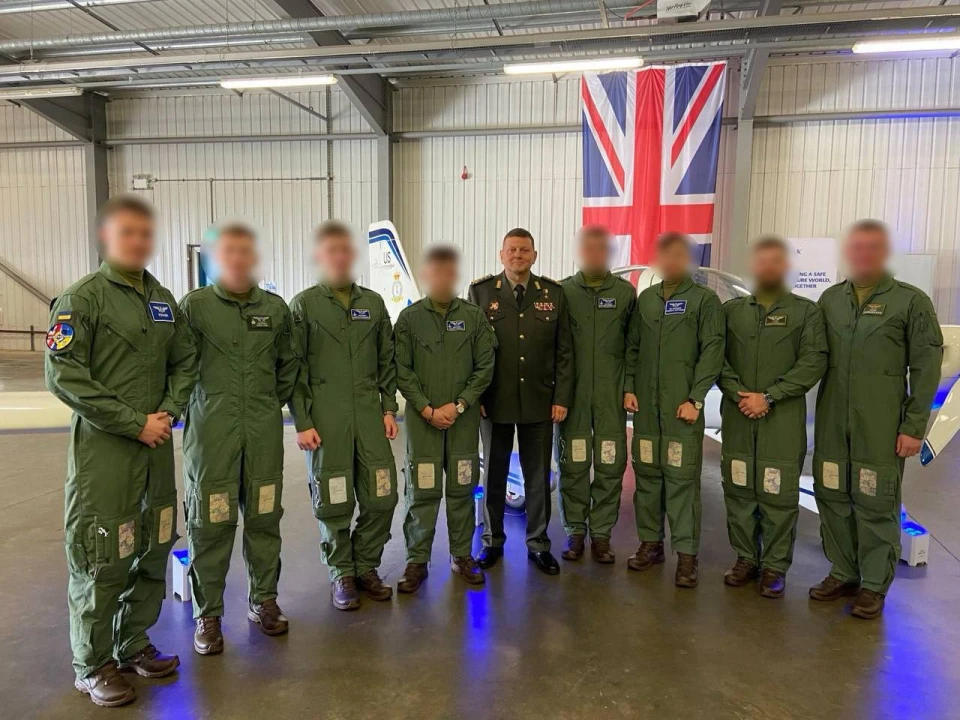
200 F-16 pilots, new details on North Korean fighters, and Russia’s “Parody” drone. Serhiy Zgurets’ column
A new group of Ukrainian Air Force pilots has wrapped up their training at the Royal Air Force base in the UK. Meanwhile, Russia has introduced the so-called "Parody" drone at the front lines
Ukrainian pilots training in the UK
A group of Ukrainian pilots has completed their training in the UK. The next phase will involve advanced training on faster jets, including the F-16. This was confirmed by the British Air Force, with Ukraine's Ambassador to the UK, Valeriy Zaluzhnyi, attending the event. However, Deputy UK Defense Minister Luke Pollard added a surprising twist by claiming on X (formerly Twitter) that 200 Ukrainian pilots had been trained and would soon be flying Western F-16s.

Photo: Telegram/Valeriy Zaluzhnyi
If we go by the photos, though, only eight Ukrainian pilots were present at the graduation ceremony. This is reportedly the second group, following a similar batch of eight pilots trained in the UK earlier. These pilots trained on basic aircraft, with F-16 training scheduled to take place in other countries. We know some pilots are training in the U.S., and another training program is set to begin at a new center in Romania. The UK has been training graduates from Ukraine's Kharkiv National University of the Air Force since last year — a two-year program that covers everything from mastering technical English to piloting light aircraft. After this, they’ll move on to F-16 training.
As for the “200 pilots” mentioned by Pollard, it likely includes more than just pilots. It probably refers to a wider range of specialists involved in flight operations — technicians, engineers, and other staff essential to maintaining and operating aircraft. Typically, for every one pilot, you need around ten support personnel. Regardless, the positive takeaway is that the training of Ukrainian military personnel abroad is ramping up, which is key for future F-16 deployment in combat.
North Korean troops in the war against Ukraine
A new reality has been acknowledged in the United States: the involvement of North Korean troops. Just a few days ago, U.S. Defense Secretary Lloyd Austin visited Kyiv. Prior to that, he claimed there was no evidence of North Korean military forces moving to Russia or joining the conflict in Ukraine. However, Reuters reported that the Pentagon has recognized their presence. There is indeed evidence that Russia has troops from North Korea, he said. He added that what exactly they're doing remains to be seen.
In addition, South Korean officials reported today that North Korea has already sent 3,000 soldiers to Russia to support its war against Ukraine. These troops are concentrated at several training grounds, and Russia has recruited a large number of translators to facilitate communication with them. It was also noted that these North Korean soldiers are being trained to operate drones and other military equipment.
North Korean pilots
Apart from the ground forces, another development has emerged: North Korean pilots are reportedly in Russia to train on Russian aircraft. This raises numerous questions, as using North Korean pilots is a complex issue. Coordination in the air is challenging due to language barriers. Moreover, North Korea has a limited number of aircraft, such as MiG-29s, which are rarely used even by Russia.
There are theories as to why these pilots are there. Some suggest that Russia might be preparing to supply North Korea with advanced aircraft like the Su-35 to deepen their military cooperation.
Aviation expert Anatolii Khrapchinskyi, deputy general director of a leading electronic warfare equipment company, offered his analysis of North Korean pilots' involvement.
"The aircraft best suited for North Korean pilots would be the Su-25. They are allowed to fly this aircraft, but the language barrier remains an issue when coordinating operations. It's likely that Putin wants to train these pilots now so they can later be equipped with Su-35, Su-30, or Su-34 aircraft. The retraining could take 9 to 12 months due to the language challenges. There’s also the possibility of them flying other aircraft like MiG-29s or helicopters such as the Mi-24, Mi-26, or Mi-8, but that remains to be seen," Khrapchinskyi noted.
New Russian Shahed drone modifications
The Russians have introduced new drones that seem to be a stripped-down version of their typical models. Russian sources are calling these drones "Parody." Alongside the well-known "Geran" and "Gerbera," the "Parody" drone now adds a new challenge, featuring design elements like balls, which seem to complicate countermeasures. These modifications don't necessarily defeat Ukraine's defenses but increase the workload on its air defense systems.
"The main aim here is to overload our anti-aircraft defenses. It’s important to understand that this is just a plastic ball printed with a 3D printer and wrapped in foil. This creates a large dispersion area similar to that of a 'Shahed.' That’s why our radar systems pick it up as an aerial target, like a Shahed, which forces our Air Defense Forces to react the same way they would to an armed drone. The challenge here is that these decoys are being used alongside Russia’s actual strikes, which include around 1,400 attack drones per month. This places a massive burden on our air defense. We're now detecting some drones primarily by sound or video footage, and these new drones are making that even harder," said Anatolii Khrapchynskyi.
According to him, there’s an increasing need for systems specifically designed to detect drones like the "Shahed" and other strike drones.
"In terms of drone imitation tactics, this isn’t new. The Soviets used similar methods with missiles like the E95M, and the Kh-55 was also used as a decoy to test air force and air defense responses. The Americans have their own history with decoy drones, like the ADM-160 and ADM-20, which simulated air targets. This tactic of using both physical decoys and electronic warfare tools to simulate missile launches is a fairly common practice. The key now is to learn how to properly detect and counter these decoys, and to automate interception. When Russia first started, they deployed 20-60 Shaheds per month. Now, we’re seeing numbers closer to 1,500," he added.
This highlights the need to improve interception capabilities.
"Mobile groups were once an effective solution, but the sheer number of air targets that need to be intercepted is physically exhausting for these groups. That’s why we’re talking about the need for systems that automatically intercept targets. While Ukrainian engineers have already developed some solutions, we need to explore technologies like AI or algorithms that can work together automatically. For instance, radar equipment could guide them directly to the target," the aviation expert explained.
Anatoliy Khrapchynskyi also discussed the possibility of creating tools that can differentiate between actual "Shahed" drones and decoys.
"First, we’re dealing with a shortage of radars capable of detecting aerial targets at these low altitudes. These drones fly at heights of up to 500 meters, meaning traditional radars don’t pick them up. Their effective radar cross-section is so small that we only detect them at short distances. Radars that cover ranges of 20 to 30 kilometers are sufficient for interception, but we need to consider how many mobile groups or radars would be needed across 100 or 400 square kilometers to detect and intercept them. Sure, you can use more advanced radar systems with phased arrays and complex antennas, but that’s a costly solution. This is why Russia deploys large numbers of ‘Shahed’ drones — to strain our defense systems. The goal now is to find an affordable solution that covers low altitudes, essentially creating a radar field that allows us to detect and neutralize these threats," he noted.
Electronic components for defense
Anatolii Khrapchynskyi, representing the company that supplies the Armed Forces with various models for countering enemy drones, discussed current trends, production challenges, and component availability. There has been ongoing debate about moving from Chinese components to Ukrainian or European alternatives.
"First, let’s clarify that most of the components used in electronic warfare systems are Ukrainian-made. However, this doesn’t include microelectronics. Here, there’s a push to switch to European or American models, but that comes with a threefold price increase. We still need tactical tools — like anti-drone guns and devices to protect trenches or transport — that require mass production. These devices need to be in every trench, on every vehicle, protecting our soldiers. We also have to remember these are consumables, often destroyed by Russian mortar or artillery strikes. So, there’s a shift toward developing more powerful systems that can work at ranges of 30-35 kilometers while still being mobile," Khrapchynskyi explained.
He noted that one growing trend is the development of more long-range systems to protect troop movements.
"For mobile electronic warfare, we might be looking at robotic platforms. These could disrupt enemy operations and create obstacles during attacks. We also can’t forget some Soviet-era innovations. For example, a Bulgarian company developed artillery shells that could block radio communications within a 500-meter radius, cutting off enemy units during attacks. So, there are plenty of potential solutions, and we’ll see more interesting developments soon. Right now, the priority for electronic warfare is to ensure strong communication with our pilots, allowing them to operate under our own electronic defenses. We’re even looking at integrating AI into these systems, and I believe we’ll see some fascinating solutions in the near future," he added.
He also discussed how the company handles adjusting the EW to match the frequency shifts of Russian FPV drones.
"I’d say it’s not hard for us to manage this. We’ve developed generators that operate between 0 and 8,000 MHz. This allows us to stay right in the action and offer the military ways to upgrade some tools so they can keep working after frequency changes or switches. Most of the products we offer are modular, meaning we can quickly add or remove certain ranges. For example, our dome solution uses the same modular approach, allowing you to adjust specific frequencies easily. Plus, the new systems we’ll produce will come with detection tech that automatically activates electronic warfare (EW) systems mounted on vehicles. This is crucial because energy gets wasted when EW systems run without any threats — like when a vehicle is on the move but no danger is present. With detection, we’ll extend the operational time and improve overall effectiveness," Anatolii Khrapchynskyi explained.
He also pointed out that there’s competition among Ukraine's electronic warfare equipment manufacturers.
"Of course, there’s competition with different price ranges available. But it's important to note that Ukrainian manufacturers are currently underutilized. In reality, if all companies were working at full capacity, we could fully supply our Defense Forces. There are programs in place that allow countries like Denmark to purchase our products and deliver them straight to the front lines. There are two key solutions that could further help our manufacturers. First, opening the option to sell some products abroad would generate funds for development, allowing us to constantly modernize and innovate. Second, we need to talk about updating the law on public-private partnerships. This would distribute risks between companies and the state, making it more appealing for foreign investors to partner with Ukrainian companies on joint ventures," the expert added.
- News











































